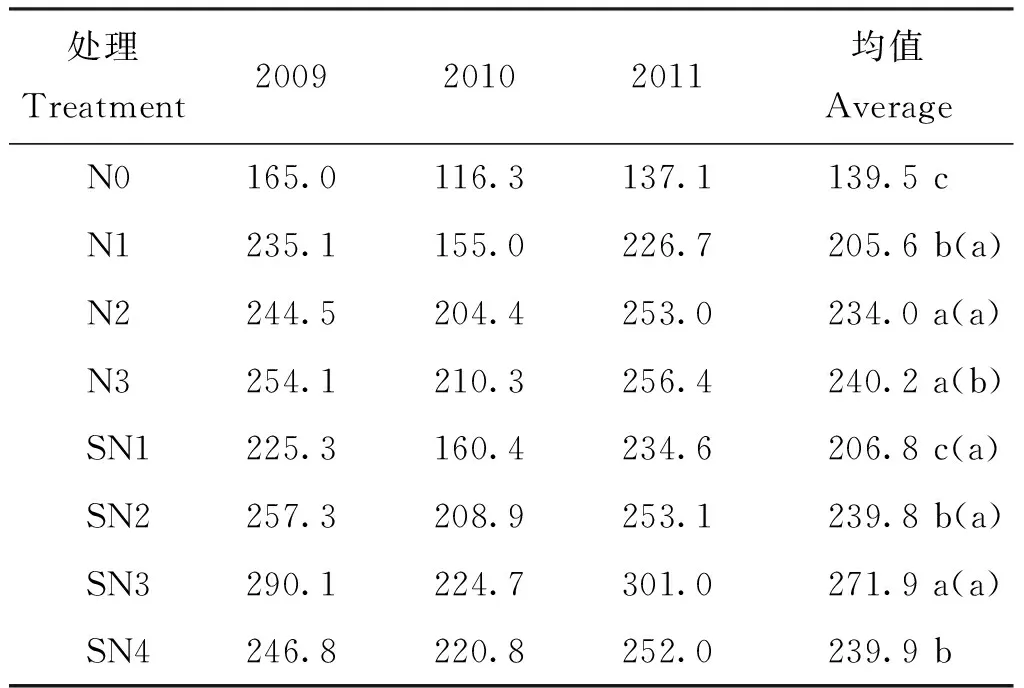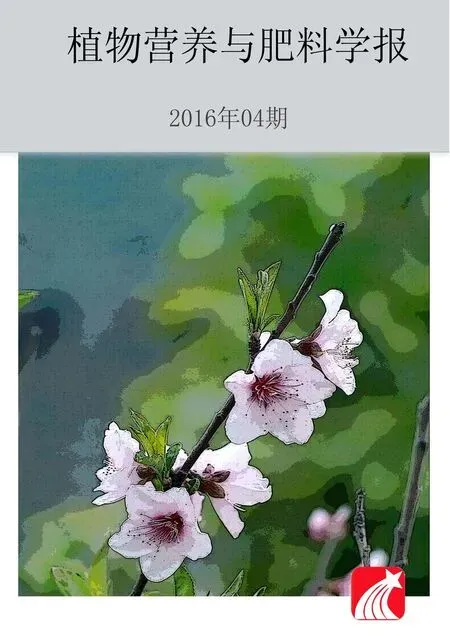秸秆全量还田与氮肥用量对水稻产量、氮肥利用率及氮素损失的影响
张 刚, 王德建, 俞元春, 王 灿, 庄锦贵
(1 南京林业大学生物与环境学院, 南京 210037; 2 中国科学院南京土壤研究所, 南京 210008;3 南京林业大学南方现代林业协同创新中心, 南京 210037)
秸秆全量还田与氮肥用量对水稻产量、氮肥利用率及氮素损失的影响
张 刚1,2,3, 王德建2, 俞元春1,3*, 王 灿2, 庄锦贵2
(1 南京林业大学生物与环境学院, 南京 210037; 2 中国科学院南京土壤研究所, 南京 210008;3 南京林业大学南方现代林业协同创新中心, 南京 210037)

秸秆还田; 氮肥用量; 氮肥利用率; 氮素损失率; 水稻产量
1 材料与方法
1.1试验设计
试验采用原状模拟土柱,采集土柱的PVC管高度为100 cm,内直径为48 cm,采集土柱深度为85 cm,在每个土柱距表土80 cm深度安装一侧向渗漏水采集管,80 cm深度下置一石英沙盘,通过侧向管控制原装土柱的渗漏量,原状土柱采集方法依据文献[13]。试验设置为裂区设计,秸秆还田(S)为主处理,氮肥用量(N)为副处理,主处理为秸秆全量还田与不还田两个处理,副处理设置5个N水平: 0、 120、 180、 240和300 kg/hm2,秸秆还田与施氮组合共8个处理,依次为N0、 N1、 N2、 N3、 SN1、 SN2、 SN3和SN4,3次重复,共24个模拟土柱。
氮肥40%做基施、 20%和40%分别做分蘖肥、 穗肥追施,磷钾肥用量均为P 15 kg/hm2和K 90 kg/hm2,磷肥为过磷酸钙,钾肥为氯化钾,均作为基肥一次施入。麦秸(5000 kg/hm2)经切碎后(约0.5 cm),随耕地翻埋地下,麦秸有机碳含量为440.5 g/kg,全氮含量为4.02 g/kg,碳氮比为109.5。供试水稻品种为南粳46,水稻栽插密度为23穴/m2。
1.2测定项目与方法

1.2.2 水样测定于水稻移栽后的第2天开始采集土柱底层淋溶水(80 cm),施肥后每2天采集一次,平常每10 天采集1次,直至水稻收获。所采水样经处理后放入冰箱中保存并尽快测定,分析总氮浓度,采用K2S2O8氧化—紫外分光比色法测定[14]。
1.2.3 植物样测定水稻成熟后测产,籽粒产量以14%水分计。每个小区选取有代表性植株25株,分别测定籽粒、 秸秆全氮含量,测定方法采用H2SO4-混合加速剂-蒸馏法[14]。
1.2.4 土样测定水稻收获后,采集耕层土壤(0—15 cm),风干,粉碎过0.25 mm筛,采用凯氏定氮法测定土壤全氮含量[14]。
1.3计算方法及数据分析
以肥力差减法计算氮肥农学利用率、 氮肥表观吸收率、 氮肥淋溶损失率、 氮肥氨挥发损失率、 氮肥土壤残留率等[15-16],其计算公式分别为:
氮肥农学利用率(Grain kg/kg N)=(施氮区籽粒产量-对照区籽粒产量)/施氮量
氮肥表观利用率(%)=(施氮区作物吸氮量-对照区作物吸氮量)/施氮量×100
氮肥氨挥发损失率(%)=(施氮区氨挥发量-对照区氨挥发量)/施氮量×100
氮肥淋溶损失率(%)=(施氮区氮素淋溶量-对照区氮素淋溶量)/施氮量×100
氮素耕层土壤残留率(%)=(施氮区氮素残留量-对照区氮素残留量)/施氮量×100
根据氮的质量守恒原理计算氮肥在整个水稻生育期的其他损失率和损失量,包括未监测的土壤残留(15—80 cm)、 径流损失及N2、 N2O等气体损失。
所有试验数据分析采用Microsoft Excel 2010与SPSS软件。
2 结果与分析
2.1秸秆还田配施氮肥对产量的影响

表1 秸秆还田配施氮肥对水稻产量的影响(g/soil column)
注(Note): 同列数据后不同字母表示处理间差异显著,括号内不同字母表示相同施氮量下不同秸秆处理间差异显著(LSD法检验) Values followed by different letters are significantly different among N treatments at the 5% level, and different letters in brackets are significantly different between the S+N treatments and N treatments under the same N application rate according to LSD test.
在施用等量氮肥情况下,SN3和N3处理水稻产量差异显著,SN2和N2处理、 SN1和N1处理差异均不显著。相较单施氮肥处理,除2009年第一季水稻产量SN1处理低于N1处理外,秸秆还田配施氮肥处理水稻产量均高于单施氮肥处理,在N1、 N2和N3水平下,3年平均增产分别为6.7、 5.8和31.7 g/土柱,增产率分别为 3.5%、 2.5%和12.8%,平均增产率为6.3%,其中SN3 处理水稻产量增幅最高。
2.2秸秆还田配施氮肥对水稻氮素利用率的影响


表2 秸秆还田配施氮肥对水稻氮素利用率的影响(2011)
注(Note): 同列数据后不同字母表示处理间差异显著,括号内不同字母表示相同施氮量下不同秸秆处理间差异显著(LSD法检验) Values followed by different letters are significantly different among the N treatments at the 5% level, and different letters in brackets are significantly different between the S+N treatments and N treatments under the same N application rate according to LSD test.


2.3秸秆还田配施氮肥对稻田氨挥发损失的影响

N0处理稻季氨挥发总损失量为2.04 kg/hm2,N1、 N2和N3处理分别为5.69、 7.04、 10.01 kg/hm2,不同施氮处理间差异显著,并且苗期、 分蘖期和抽穗期不同施氮水平间氨挥发损失量差异显著,氨挥发损失量均随施氮量的增加而增加。在相同施氮水平下,SN3处理在苗期、 分蘖期和抽穗期的氨挥发损失量分别占氨挥发损失总量的35.0%、 47.3%和17.7%,其中苗期和分蘖期与N3处理差异显著,抽穗期差异不显著; SN3处理与N3处理氨挥发总损失量差异显著,SN3处理氨挥发总损失量比N3处理增加了18.2%。

表3 秸秆还田配施氮肥水稻的氨挥发损失(kg/hm2, 2010)
注(Note): 同列数据后不同字母表示处理间差异显著(LSD法检验) Values followed by different letters are significantly different among the N treatments at the 5% level according to LSD test.
2.4秸秆还田配施氮肥对稻田氮素淋溶损失的影响


表4 秸秆还田配施氮肥水稻氮肥的淋溶损失(20092011)
注(Note): 同列数据后不同字母表示处理间差异显著,括号内不同字母表示相同施氮量下不同秸秆处理间差异显著(LSD法检验) Values followed by different letters are significantly different among N treatments at the 5% level, and different letters in brackets are significantly different between the S+N treatments and N treatments under the same N application rate according to LSD test.
在相同施氮水平下,秸秆还田配施氮肥处理和单施氮肥处理的氮肥淋溶损失年度变化趋势不一致,2009年SN1和SN2处理氮肥淋溶量分别小于N1和N2处理,SN3处理高于N3处理,2010年SN1、 SN2和SN3处理氮肥淋溶量均小于单施氮肥处理,2011年SN1和SN2处理氮肥淋溶量分别高于N1和N2处理,SN3处理低于N3处理。本试验中3年平均氮肥淋溶量显示,秸秆还田配施氮肥处理和单施氮肥处理没有显著性差异,其中SN1和SN2处理氮肥淋溶量高于N1和N2处理,平均增加14.5%的氮肥淋溶损失; SN3处理氮肥淋溶量低于N3处理,减少30.9%的氮肥淋溶损失。
2.5秸秆还田配施氮肥对氮肥土壤残留量的影响
试验进行3年后,于2011年水稻收获后采集耕层土壤(0—15 cm)并分析其全氮残留量。图1表明,当施氮量为120、 180和240 kg/hm2时,氮肥在土壤的残留量分别为28.9、 37.3和49.5 kg/hm2,呈明显的增加趋势; 而相对应的氮肥在土壤中的残留率分别为24.1%、 20.7%和20.6%,呈下降趋势。由此可见,氮肥在土壤中的残留量受施氮量的控制,随施氮量的增加而增加,而残留率随施氮量的增加而降低。秸秆还田配施氮肥处理下土壤氮肥残留变化规律与单施氮肥变化规律基本一致(图1)。

图1 氮肥在0—15 cm土壤中的残留Fig.1 Fertilizer N residual in 0-15 cm soil of rice field under different treatments
在相同施氮水平下,氮肥在土壤中的残留量表现为秸秆还田配施氮肥处理大于单施氮肥处理,SN1、 SN2、 SN3处理较N1、 N2、 N3处理残留量分别增加8.4、 11.0、 10.1 kg/hm2,平均增加9.8 kg/hm2,残留率分别增加7.0、 6.2、 4.2个百分点,平均增加5.8个百分点,这表明秸秆还田可以加强土壤对氮肥的持留,增加土壤的含氮量,提高氮肥在土壤中的残留率。
2.6秸秆还田配施氮肥对稻田氮肥总损失量的影响
本试验中氮肥的总损失量包括径流损失氮、 淋溶损失氮、 气态损失氮以及15—80 cm土层的残留氮,因本试验中没有监测15—80 cm土层的残留氮、 径流损失氮以及N2、 N2O等气体损失。因此,采用氮素守恒法计算不同处理的氮肥总损失量和总损失率(表5)。


表5 不同处理氮肥总损失量和损失率(2011)
3 讨论




通过上述研究结果表明,秸秆全量还田下配施氮肥可以提高水稻产量、 氮肥农学利用率、 氮肥表观利用率,降低氮肥的总损失率。因此,在本试验条件下,综合考虑水稻产量、 氮肥利用率、 氮肥损失率及氮肥土壤残留状况,麦秸全量还田下配施N 240 kg/hm2是稻麦轮作地区兼顾水稻产量、 土壤肥力保持、 环境安全等方面的合理耕作措施,值得借鉴与推广。有关秸秆还田的残效功能对下季作物的产量及氮肥用量的影响,有待于进一步研究。
[1]江立庚, 曹卫星. 水稻高效利用氮素的生理机制及有效途径[J]. 中国水稻科学, 2002, 16(3): 261-264.
Jiang L G, Cao W X. Physiological mechanism and approaches for efficient nitrogen utilization in rice[J]. Chinese Journal of Rice Science, 2002, 16(3): 261-264.
[2]杨林章, 王德建, 夏立忠. 太湖地区农业面源污染特征及控制途径[J]. 中国水利, 2004, 20: 29-30.
Yang L Z, Wang D J, Xia L Z. Features and ways of control non-point agricultural pollution in Taihu area[J]. China Water Resources, 2004, 20: 29-30.
[3]Tian Y H, Yin B, Yang L Z,etal. Nitrogen runoff and leaching losses during rice-wheat rotations in Taihu lake region, China[J]. Pedosphere, 2007, 17(4): 445-456.
[4]冯伟, 张利群, 庞中伟, 郭淑珍. 中国秸秆废弃焚烧与资源化利用的经济与环境分析[J]. 中国农学通报, 2011, 27(6): 350-354.
Feng W, Zhang L Q, Pang Z W, Guo S J. The economic and environmental analysis of crop residues burning and reutilization in China[J]. Chinese Agricultural Science Bulletin, 2011, 27(6): 350-354.
[5]Eagle A J, Bird J A, Horwath W R,etal. Rice yield and nitrogen utilization efficiency under alternative straw management practices[J]. Agronomy Journal, 2000, 92(6): 1096-1103.
[6]Verma T S, Bhagat R M. Impact of rice straw management practices on yield, nitrogen uptake and soil properties in a wheat-rice rotation in northern India[J]. Fertilizer Research, 1992, 33(2): 97-106.
[7]马永良, 师宏奎, 张书奎, 吕润海. 玉米秸秆整株全量还田土壤理化性状的变化及其对后茬小麦生长的影响[J]. 中国农业大学学报, 2003, 8(增刊): 42-46.
Ma Y L, Shi H K, Zhang S K, Lü R H. Whole maize straw addition: the changes of soil physical and chemical properties and the effect on winter wheat[J]. Journal of China Agricultural University, 2003, 8(Suppl.): 42-46.
[8]张庆忠, 吴文良, 王明新, 等. 秸秆还田和施氮对农田土壤呼吸的影响[J]. 生态学报, 2005, 25(11): 2883-2887.
Zhang Q Z, Wu W L, Wang M X,etal. The effects of crop residue amendment and N rate on soil respiration[J]. Acta Ecologica Sinica, 2005, 25(11): 2883-2887.
[9]赵鹏, 陈阜. 秸秆还田配施化学氮肥对冬小麦氮效率和产量的影响[J]. 作物学报, 2008, 34(6): 1014-1018.
Zhao P, Chen F. Effects of straw mulching plus nitrogen fertilizer on nitrogen efficiency and grain yield in winter wheat[J]. Acta Agronomica Sinica, 2008, 34(6): 1014-1018.
[10]赵四申, 张西群, 贾素梅, 等. 玉米秸秆整株还田对小麦生长发育及产量的影响[J]. 中国生态农业学报, 2003,11(1): 145-147.
Zhao S S, Zhang X Q, Jia S M,etal. Influence of returning whole corn stalk into soil on wheat growth and its yield[J]. Chinese Journal of Eco-Agriculture, 2003, 11(1): 145-147.
[11]汪军, 王德建, 张刚. 太湖地区稻麦轮作体系下秸秆还田配施氮肥对水稻产量及经济效益的影响[J]. 中国生态农业学报, 2011,19(2): 265-270.
Wang J, Wang D J, Zhang G. Effects of different N-fertilizer rates with straw incorporation on rice yield and economic benefit of rice-wheat rotation system in Taihu Lake region[J]. Chinese Journal of Eco-Agriculture, 2011, 19(2): 265-270.
[12]徐国伟, 谈桂露, 王志琴, 等. 秸秆还田与实地氮肥管理对直播水稻产量、 品质及氮肥利用的影响[J]. 中国农业科学, 2009, 42(8): 2736-2746.
Xu G W, Tan G L, Wang Z Q,etal. Effects of wheat-residue application and site-specific nitrogen management on grain yield and quality and nitrogen use efficiency in direct-seeding rice[J]. Scientia Agricultura Sinica, 2009, 42(8): 2736-2746.
[13]王德建, 张刚, 汪军, 等. 水稻基肥尿素干施与湿施对氮素损失及水稻氮素吸收的影响[J]. 土壤学报, 2010, 47(3): 483-489.
Wang D J, Zhang G, Wang J,etal. Effects of dry deep-placement and wet broadcast of urea as basal in paddy field on nitrogen loss and plant N uptake[J]. Acta Pedologica Sinica, 2010, 47(3): 483-489.
[14]鲁如坤. 土壤农业化学分析方法[M]. 北京: 中国农业科技出版社, 2000. 128-129, 148-149, 308-309.
Lu R K. Analysis method of soil and agro-chemistry[M]. Beijing: China Agricultural Science and Technology Press, 2000. 128-129, 148-149, 308-309.
[15]张耀鸿, 张亚丽, 黄启为, 等. 不同氮肥水平下水稻产量以及氮素吸收、 利用的基因型差异比较[J]. 植物营养与肥料学报, 2006, 12(5) : 616-621.
Zhang Y H, Zhang Y L, Huang Q W,etal. Effects of different nitrogen application rates on grain yields and nitrogen uptake and utilization by different rice cultivars[J]. Plant Nutrition and Fertilizer Science, 2006, 12(5): 616-621.
[16]Lin D X, Fan X H, Hu F,etal. Ammonia volatilization and nitrogen utilization efficiency in response to urea application in rice fields of the Taihu Lake region, China[J]. Pedosphere, 2007, 17(5): 639-645.
[17]Rao, D. N., Mikkelsen D. S. Effect of rice straw incorporation on rice plant growth and nutrition[J]. Agronomy Journal, 1976, 68(5): 752-755.
[18]裴鹏刚, 张均华, 朱练峰, 等. 秸秆还田耦合施氮水平对水稻光合特性、 氮素吸收及产量形成的影响[J]. 中国水稻科学, 2015, 29(3): 282-290.
Pei P G, Zhang J H, Zhu L F,etal. Effects of straw returning coupled with N application on rice photosynthetic characteristics, nitrogen uptake and grain yield formation[J]. Chinese Journal of Rice Science, 2015, 29(3): 282-290.
[19]徐国伟, 吴长付, 刘辉, 等. 麦秸还田及氮肥管理技术对水稻产量的影响[J]. 作物学报, 2007, 33(2): 284-291.
Xu G W, Wu C F, Liu H,etal. Effects of wheat residue incorporation and nitrogen management techniques on formation of the grain yield of rice[J]. Acta Agronomica Sinica, 2007, 33(2): 284-291.
[20]吴建富, 曾研华, 潘晓华, 等. 稻草还田方式对双季水稻产量和土壤碳库管理指数的影响[J]. 应用生态学报, 2013, 24(6): 1572-1578.
Wu J F, Zeng Y H, Pan X H,etal. Effects of rice straw returning mode on rice grain yield and soil carbon pool management index in double rice-cropping system[J]. Chinese Journal of Applied Ecology, 2013, 24(6): 1572-1578.
[21]赵峰, 程建平, 张国忠, 等. 氮肥运筹和秸秆还田对直播稻氮素利用和产量的影响[J]. 湖北农业科学, 2011, 50(18): 3702-3704.
Zhao F, Chen J P, Zhang G Z,etal. Effect of nitrogen fertilizer regimes and returning straw on N availability and forming yield of direct-sowing rice[J]. Hubei Agricultural Science, 2011, 50(18): 3702-3704.
[22]张媛媛, 李建林, 王春宏, 姜佰文. 氮素和生物腐解剂调控下稻草还田对水稻氮素积累及产量的影响[J]. 土壤通报, 2012, 43(2): 435-438.
Zhang Y Y, Li J L, Wang C H, Jiang B W. Effects of rice-straw return to field on nitrogen accumulation and yield of rice under the nitrogen manipulation and biological decomposing[J]. Chinese Journal of Soil Science, 2012, 43(2): 435-438.
[23]徐新宇, 张玉梅, 向华, 胡济生. 应用15N示踪研究秸秆对保存和提高氮肥肥效的影响[J]. 中国核科技报告, 1991 (增刊3): 1-11.
Xu X Y, Zhang Y M, Xiang H, Hu J S. Effect of applying wheat stubble on preservation and utilization of N-fertilizer by15N trace technique[J]. China Nuclear Science & Technology Report, 1991 (Suppl.3): 1-11.
[24]田玉华, 贺发云, 尹斌, 朱兆良. 太湖地区氮磷肥施用对稻田氨挥发的影响[J]. 土壤学报, 2007, 44(5): 893-899.
Tian Y H, He F Y, Yin B, Zhu Z L. Ammonia volatilization from paddy fields in the Taihu Lake region as affected by N and P combination in fertilization[J]. Acta Pedologica Sinica, 2007, 44(5): 893-899.
[25]Van Asten P J A, Van Bodegom P M, Mulder L M,etal. Effect of straw application on rice yields and nutrient availability on an alkaline and a pH-neutral soil in a Sahelian irrigation scheme[J]. Nutrient Cycling in Agroecosystems, 2005, 72(3): 255-266.
[26]钱海燕, 杨滨娟, 黄国勤, 等. 秸秆还田配施化肥及微生物菌剂对水田土壤酶活性和微生物数量的影响[J]. 生态环境学报, 2012, 21(3): 440-445.
Qian H Y, Yang B J, Huang G Q,etal. Effects of returning rice straw to fields with fertilizers and microorganism liquids on soil enzyme activities and microorganisms in paddy fields[J]. Ecology and Environmental Sciences, 2012, 21(3): 440-445.
[27]Tang C, Sparling G P, McLay C D A. Effect of short-term legume residue decomposition on soil acidity[J]. Australian Journal of Soil Researeh,1999, 37: 561-573.
[28]蒋静艳, 黄耀, 宗良纲. 水分管理与秸秆施用对稻田CH4和N2O排放的影响[J]. 中国环境科学, 2003, 23(5): 552-556.
Jiang J Y, Huang Y, Zong L G. Influence of water controlling and straw application on CH4and N2O emissions from rice field[J]. China Environmental Science, 2003, 23(5): 552-556.
[29]王改玲, 郝明德, 陈德立. 秸秆还田对灌溉玉米田土壤反硝化及N2O排放的影响[J]. 植物营养与肥料学报, 2006, 12(6): 840-844.
Wang G L, Hao M D, Chen D L. Effect of stubble incorporation and nitrogen fertilization on denitrification and nitrous oxide emission in an irrigated maize soil[J]. Plant Nutrition and Fertilizer Science, 2006, 12(6): 840-844.
[30]王德建, 林静慧, 夏立忠. 太湖地区稻麦轮作农田氮素淋洗特点[J]. 中国生态农业学报, 2001,9(1): 16-18.
Wang D J, Lin J H, Xia L Z. Characteristics of nitrogen leaching of rice-wheat rotation field in Taihu Lake area[J]. Chinese Journal of Eco-Agriculture, 2001, 9(1): 16-18.
[31]汪军,王德建,张刚.秸秆还田下氮肥用量对稻田养分淋洗的影响[J].中国生态农业学报,2010,18(2): 316-321.
Wang J, Wang D J, Zhang G. Effect of incorporated straw-nitrogen fertilizer on nutrient leaching in paddy soils[J].Chinese Journal of Eco-Agriculture, 2010,18(2): 316-321.
[32]李宗新,董树亭,王空军,等.不同施肥条件下玉米田土壤养分淋溶规律的原位研究[J].应用生态学报,2008,19(1): 65-70.
Li Z X, Dong S T, Wang K J,etal. Soil nutrient leaching patterns in maize field under different fertilizations: An in situ study[J].Chinese Journal of Applied Ecology, 2008, 19(1): 65-70.
[33]王德建,林静慧,孙瑞娟,等.太湖地区稻麦高产的氮肥适宜用量及其对地下水的影响[J].土壤学报,2003,40(3): 426-432.
Wang D J, Lin J H, Sun R J,etal. Optimum nitrogen rate for a high productive rice-wheat system and its impact on the groundwater in the Taihu area[J]. Acta Pedologica Sinica, 2003, 40(3): 426-432.
Effects of straw incorporation plus nitrogen fertilizer on rice yield, nitrogen use efficiency and nitrogen loss
ZHANG Gang1,2,3, WANG De-jian2, YU Yuan-chun1,3*, WANG Can2, ZHUANG Jin-gui2
(1CollegeofBiologyandtheEnvironment,NanjingForestryUniversity,Nanjing210037,China;2InstituteofSoilScience,ChineseAcademyofSciences,Nanjing210008,China;3Co-InnovationCenterfortheSustainableForestryinSouthernChina,NanjingForestryUniversity,Nanjing210037,China)
【Objectives】 Exploration of the theory and technology of N application along with total straw incorporation has great significance for raising rice yield and N use efficiency, alleviating nitrogen pollution in rice production in China.【Methods】 A split plot field experiment was conducted using monolith lysimeter with a local rice Nanjing 46 as material in Changshu Agro-ecological Experimental Station, Jiangsu Province, China from 2009 to 2011. The main plot was total wheat straw incorporation (S) and no straw incorporation (S0); the sub-plots were four N rates: 120 kg/hm2(N1), 180 kg/hm2(N2), 240 kg/hm2(N3) and 300 kg/hm2(N4), with no N application as control (CK). The amount of ammonia volatilization, total N contents in leachate and soil, the N contents in straw in different growth periods and grains were determined, the rice yields were investigated.【Results】 The rice yield was increased with the increasing of N application rate. Compared with no straw incorporation treatments, the average rice yields of S+N treatments were increased by 6.3%, and the highest yield was obtained in SN3 treatment. N use efficiencies were declined with the increasing of N rates in rice reason, which could be enhanced by straw incorporation. Agronomic N efficiency and N apparent recovery in S+N treatments were all higher than those of N treatments by 1.4-3.4 kg/kg and 1.8%-4.2% respectively. With the increasing of N application rate, the amount of N residual, ammonia volatilization and N leaching in paddy field increased. Compared with no straw incorporation, the amount of ammonia volatilization and N residual in paddy field with straw incorporation was increased by 18.2% and 10.1 kg/hm2respectively at N application rate of 240 kg/hm2, and the N leaching and total N loss were reduced by 30.9% and 6.0% respectively.【Conclusions】 Under the straw completely incorporation, optimum N application rate could increase the N efficiency and rice yield, reduce the total N loss. In this research, the wheat straw incorporation with N application of 240 kg/hm2is the optimal mode.
straw incorporation; nitrogen application rate; nitrogen use efficiency; nitrogen loss; rice yield
2015-04-17接受日期: 2015-07-22网络出版日期: 2016-05-23
江苏省农业科技自主创新资金项目“区域秸秆全量利用关键技术研究与项目推广”[CX(12)1002] ; “十二五”国家科技支撑资助项目(2012BAJ24B06); 国家自然科学基金项目(31270664); 江苏省普通高校研究生科研创新计划项目(KYLX15_09)资助。
张刚(1980—), 男, 山东新泰人, 博士, 助理研究员, 主要从事土壤、 农业生态环境方面的研究。E-mail: gzhang@issas.ac.cn
E-mail: ycyu@njfu.edu.cn
S511.062.01
A
1008-505X(2016)04-0877-09

